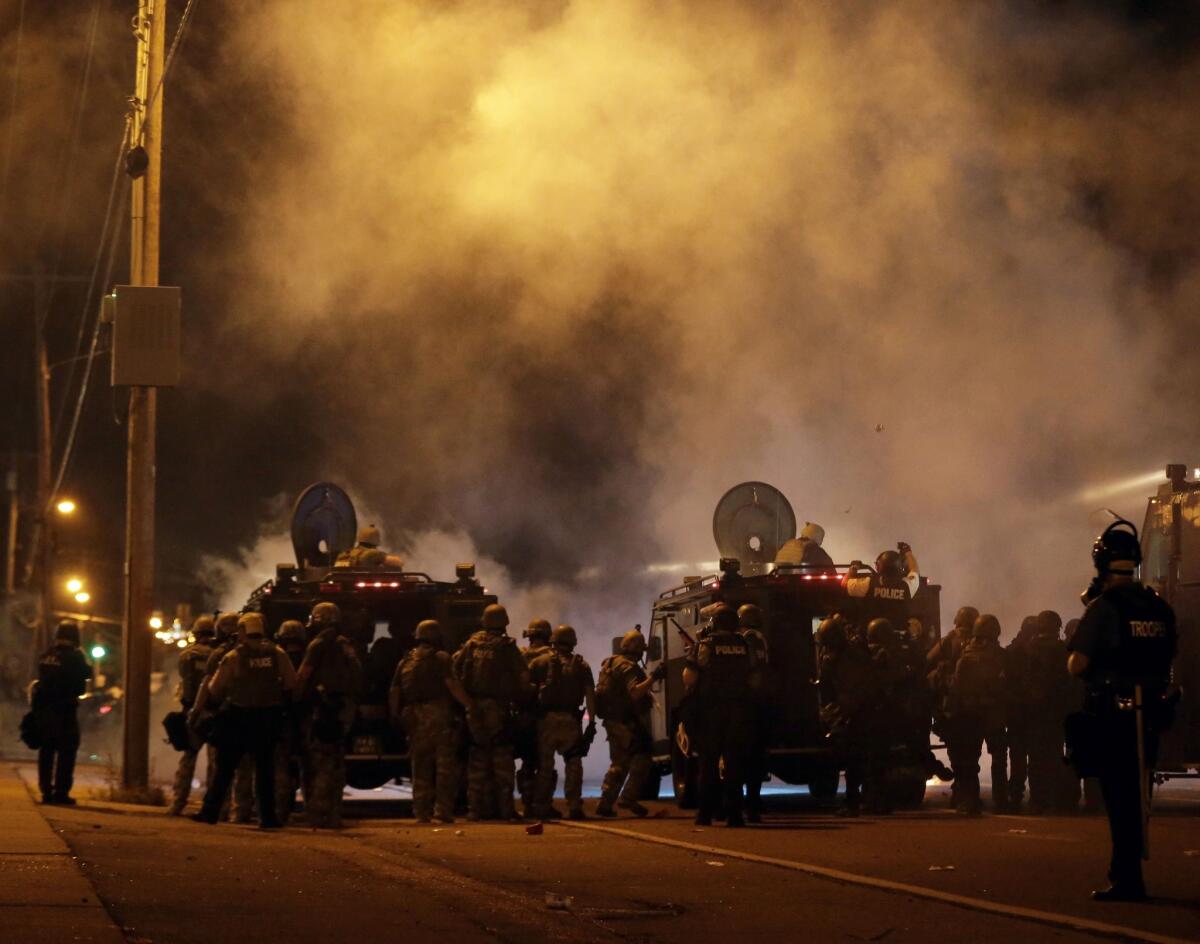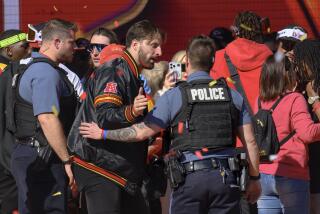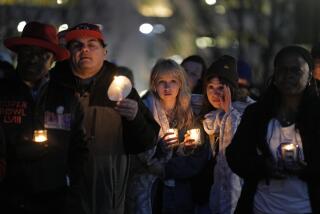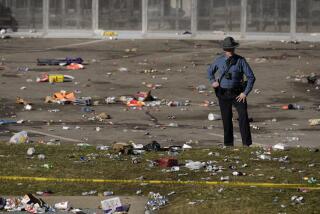Missouri governor orders National Guard to help quell Ferguson unrest

- Share via
Reporting from Ferguson, Mo. — Missouri Gov. Jay Nixon early Monday ordered the National Guard deployed to Ferguson, where another night of violence saw police pelted with bottles and Molotov cocktails and looters rampaging through local businesses.
The executive order directs the resources of the National Guard “to help restore peace and order and to protect the citizens of Ferguson.”
“Tonight, a day of hope, prayers and peaceful protests was marred by the violent criminal acts of an organized and growing number of individuals, many from outside the community and state, whose actions are putting the residents and businesses of Ferguson at risk,” the governor said in a statement.
LIVE COVERAGE: Images from the streets in Ferguson
At least two people were shot Sunday night, and police were fired upon in street protests that have escalated since the Aug. 9 shooting of an unarmed 18-year-old black youth, Michael Brown, by a white police officer in this largely black St. Louis suburb.
Police said there were signs of a pre-planned and coordinated attempt to disrupt the city and launch an advance on the police command post not far from the scene of the shooting.
“There were shootings, vandalism and other acts of violence that clearly appear not to have been spontaneous but premeditated criminal acts,” Missouri Highway Patrol Capt. Ron Johnson told reporters early Monday.
“The catalyst was not civil disobedience, but pre-planned agitation,” he said.
At one point, a McDonald’s restaurant that has been near the center of the street agitation in recent days was overrun by unruly protesters, forcing employees to lock themselves in a storage room, Johnson said.
Not far away, police fired tear gas at a large crowd as protesters swept toward the main police command post, hurtling bottles and bottle rockets, he said. Authorities received reports of at least two people shot during the evening, though police were not involved in either incident. The extent of their injuries was not known.
“Based on these conditions, I had no alternative but to elevate the level of our response,” Johnson said.
“We are planning additional steps to quiet the violence. We are all determined to restore peace and safety to the people of Ferguson, and I believe the continued resolve of the good people of this community will ultimately triumph over the few people bent on violence and destruction,” he said.
The new street eruptions came as a private autopsy revealed that Brown had been shot at least six times, including twice in the head.
Anthony Gray, an attorney for the Brown family, said a diagram provided by New York forensic pathologist Dr. Michael Baden, commissioned by the family to do an independent examination, revealed details of the bullets that struck Brown’s body.
The fact that one of the shots struck the top of Brown’s head, Gray said, was significant.
“To have a shot that’s at a 90-degree angle from the top of his skull to the bottom of his chin, almost vertical, that sounds like an officer standing over him,” Gray said.
Baden said his examination suggested that none of the six bullets was fired at point-blank range, but all were fired from at least one to two feet away.
“There’s no evidence of powder residue,” Baden said in a telephone interview with the Los Angeles Times.
Baden said two bullets struck Brown in the head: one in the forehead and one at the top of the head — fired at “a right angle to the top of the head.”
“The top of the head one was the one that would have made him unconscious and fall to the ground,” Baden said.
But it is difficult to draw firm conclusions from that, he said, without also considering witness statements and marks on Brown’s clothing. “The head is very movable, and it can be in a number of positions,” he said.
At least one of the wounds to Brown’s arm “could have been defensive,” Baden said.
Police say Brown had participated in a strong-arm robbery at a mini-mart shortly before his encounter with Ferguson Police Officer Darren Wilson.
Wilson, police said, was confronted by Brown inside his police car in a scuffle that led to the shooting. At least one witness who was accompanying Brown that afternoon has said Brown was shot as he walked away from the police officer with his hands raised, and then was hit with additional bullets.
The latest round of street clashes Sunday began about 8:30 p.m. -- well before the midnight curfew.
A large group of protesters marched toward a shopping center containing a police command post. They held their hands aloft, chanting “Hands up, don’t shoot.”
Police began lobbing smoke canisters and tear gas toward the marchers when they neared the command post and refused to back down.
At first protesters fled, then held their ground in the middle of the street. A few protesters grabbed smoke canisters from the street and hurled them back at police. Large numbers of people found themselves unable to flee as police advanced in half a dozen military-style vehicles because the street was blocked by the crowd behind them.
Johnson said the first sign of problems came at 8:25 p.m., with reports of someone shot. A number of officers responded but shots were fired at them and Molotov cocktails were hurled in their direction as they approached, he said.
Within minutes, more shots were fired to the north and there were reports of another person shot. At least eight people were seen with guns, Johnson said.
Looting began at several businesses, including a pizza restaurant and an auto parts store, and shortly before 9 p.m. the crowd began approaching the police command post at the shopping center, he said.
Officers called in support from other police agencies and began deploying tear gas, Johnson said.
No officers were injured.
Citizens appeared stunned by the level of mayhem even after nearly a week of nightly protests.
“It’s unbelievable. This is something you would see on TV in a third-world country. Tear gas — I’ve never seen it escalate to that point,” said Martin McDonald, 38, a truck driver from the town of Florissant who said he joined the protests for the first time on Sunday.
Chris Hudson, 31, a construction worker, said he wished protesters would gather near the police station, instead of paralyzing a residential area.
“I feel like they’re taking advantage of the situation,” he said as stood on the side of the street, watching as police advanced in a cloud of gas.
“They should have let people be. It’s not even 12 yet,” said Nikki Chamberlain, 36, referring to the midnight-to-5-a.m. curfew ordered by Nixon on Saturday. “It’s like they didn’t give us a chance.”
She watched as a young man threw a gas canister back at police.
“Good,” she said. “Give them a taste of their own medicine.”
She gestured into the surrounding darkness.
“Somewhere out there, there’s still people’s houses getting broken into, people getting raped, kids getting molested. And they’re out here with people demonstrating peacefully. A peaceful situation turned into a war. We’re not here acting like animals,” she said.
Kenny Thompson, 21, said protesters were marching peacefully until confronted with a heavy police response.
“I feel like the situation got out of hand when the police came toward everyone in so much force instead of coming toward everyone in a polite way,” he said. “We were all sitting here responding just fine, us people, walking, talking — whites and blacks, no racism at all. But the officers came full force, shooting mace and tear gas.”
Thompson rubbed his eyes and doused his face with a bottle of water after inhaling the gas. Several gunshots were heard, and Thompson called out to those who began running.
“It’s OK, he shouted. “That’s our people shooting at the cops.”
Earlier Sunday, Ferguson had hopes for peace. More than 1,300 people gathered for a rally at the Greater Grace Church, filling the sanctuary and spilling out the door.
The Brown family hosted the event, along with the National Bar Assn. and civil rights leader Al Sharpton’s National Action Network. Sharpton and Martin Luther King III called for the nation to respond constructively and address what Sharpton called the militarization of police.
Sharpton told the community to take positive action. “Don’t loot in Michael’s name,” he implored.
He also told residents to vote, noting that the 12% turnout in the last election “is an insult to your children.”
But the most celebrated speaker was Johnson, who took over the police response last week at the direction of the governor.
Johnson, dressed in his uniform and wearing his badge, told the audience that he had met with some of Brown’s relatives on Saturday.
“They brought tears to my eyes and shame to my heart,” Johnson said. “I wear this uniform. And I should stand up here and say I’m sorry.”
The crowd erupted in cheers.
Brown’s death will make the world safer for young black men, Johnson said.
“When this is over, I’m going to go in my son’s room, my black son, who wears his pants sagging, wears his hat cocked to the side, got tattoos on his arms, because that’s my baby,” he said.
“Michael’s going to make it better for our sons.”
Follow @mollyhf and @kurtisalee for more national news
More to Read
Sign up for Essential California
The most important California stories and recommendations in your inbox every morning.
You may occasionally receive promotional content from the Los Angeles Times.











